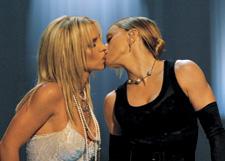“Is the age-old male ménage-à-trois fantasy influencing the next generation of young women to flex their sex?” asks ABC News in a recent attempt at exposé. “Or is it the celebrity endorsement à la Katy Perry singing, ‘I kissed a girl and liked it’?”
According to ABC’s report, “Flexisexual: Girls Who Kiss Girls But Like Boys” (which includes video and print segments), “women have been loosening up sexually with other women” — ahem — ever since Madge and Britney Spears infamously locked lips at the 2003 MTV Video Music Awards.
Says ABC: “These so-called flexisexuals say that although they are not gay or even bisexual, they enjoy flirting [with] and kissing girls.”
ABC then goes on to explore the motivation behind this so-called breaking “phenomenon,” only to deduce — via various “experts” and straight college-aged girls — that this may well be the “product of a generation unconcerned with labels” thanks in part to “the growing visibility of same-sex couples.”
But the impulse to flex one’s sexuality ultimately resides in illegitimacy: booze (“We’re usually drunk when it happens,” says one interviewee); the four-year phase (It’s not real life! It’s college!); the male gaze (T&A plus T&A equals his rock-hard attention!); and of course, the “celebrat[ory]” attitude of “pop culture” (Indoctrination Nation! Beware the impact of pop culture’s sexually “lax attitude,” especially “among younger, easily influenced girls.”)
ABC, however, is tardy in its trend reportage — back in November 2010, Louise Eccles broke “flexisex” ground with her Daily Mail article, “Dawn of the Flexisexual: The New Word for the Women Who Refuse to Play It Straight.”
(Of course, as Lauri Apple at jezebel.com notes, similar definitions of flexisexual have been circulating at urbandictionary.com since 2008. )
Eccles focuses on women in their 30s and 40s (versus ABC’s young women), and she defines flexisexuality differently: “[S]traight women who flirt with bisexuality… people who have a sexual preference but refuse to be bound by it.”
Still, elements of ABC’s exposé have been directly copped from Eccles: the notion that “flexi” is brand new buzz, its supposed Madge/Britney/Perry-inspired genesis, and the use of Sapphically inclined celebrities Angelina Jolie, Drew Barrymore and Lindsay Lohan as evidence.
Of course, each of these claims is invalid. Sexual experimentation is not a newfangled activity, nor has its practice been engineered by Madonna. Moreover, Jolie, Barrymore and Lohan are not flexisexual — each of these women has explicitly identified as bisexual.
Jolie has proclaimed her bisexuality since the late ’90s (when she dated model/actress Jenny Shimizu), and in 2003, when Barbara Walters attempted to set the record straight, Jolie’s response to Walters’ are-you-bisexual query was unambiguous: “Of course.”
Barrymore has also declared her bisexuality since the late ’90s, and when New Woman tabled the issue again in 2003, Barrymore’s response was unequivocal: “Do I like women sexually? Yeah, I do. Totally. I have always considered myself bisexual.”
And when in 2008 Harper’s Bazaar asked Lohan — who was in the thick of her year-long relationship with DJ Samantha Ronson — if she was bisexual, Lohan responded, “Maybe. Yeah.”
The fact that ABC and Eccles confuse bisexuality with flexisexuality suggests an inability to reconcile sexual identities that don’t fit into the hetero-homo dyad. Indeed, both articles are careful to point out that Jolie is “now” dating Brad Pitt and that Lohan “has since returned to men.”
Ultimately, it’s the sexual identity of conservative culture that’s at stake here: Go ahead and flex your sexuality, ladies. It’s okay because we know that the moment you shack up with a dude, it’s for real.
Not only does this attitude wholly invalidate bisexual and queer identities, it insists upon a hierarchy of sexuality, wherein heterosexuality sits firmly at the apex.
Funny. Because — as Anthony D Poerio, in his discussion of Eccles’ article at scallywagandvagabond.com, notes — the notion of flexisexuality has the potential to dismantle the categorical mistakes through which we understand ourselves.
Says Poeri, flexisexuality is “less about the type of sexual behaviour in question than it is about identity, or more pointedly, this refusal to identify oneself with an accepted definition, an easily quantified cut-and-paste category.” Flexisexuality, then, could be construed as “an attempt at reclaiming one’s non-binaristic individual sexual identity — thereby presenting a challenge not just to what it means to be defined as straight or gay, but what it means to be defined as sexual.
“There is no ‘mostly straight’ herein, as there is no ‘straight’ at all, instead only flexibility, multiplicity and plurality.”

 Why you can trust Xtra
Why you can trust Xtra


